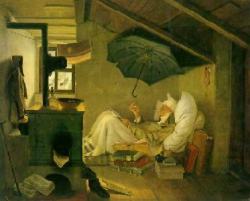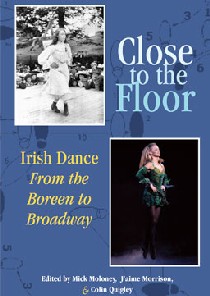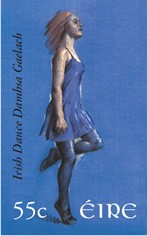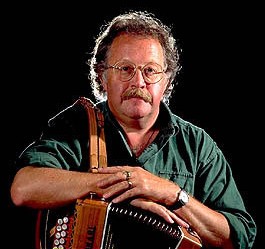|
T:-)M's Night Shift From Boreen to Broadway |

|
FolkWorld Issue 43 11/2010; Book Reviews by Walkin' T:-)M & Pío Fernández
|
T:-)M's Night Shift From Boreen to Broadway |

|
Northern Irish mystery writer Colin Bateman wondered in one of his latest novels, "... my knowledge of dance was so poor that I couldn't be sure that Northern Ireland had contributed anything at all to the bigger picture ..." Ulster probably did and it wasn't much different to other parts of Ireland I suppose.
|
|
 Mick Moloney, J'aime Morrison & Colin Quigley (eds) Close to the Floor - Irish Dance from the Boreen to Broadway. Macater Press, 2009, ISBN 978-0-9814924-4-5, pp155, US$22.95. |
Where is the land can boast a dance which equals that of Ireland - what is all the fuss about Irish dancing, and Irish step dancing in particular? In an Irish magazine you could read: Here one saw a truly Irish gathering: fine, clean youth, decent and sober; wholesome dancing, free from all taint of the sensual. (1931)
Meanwhile Irish dancing had conquered the world and inspired thousands, if not millions of people - not only from boreen to broadway, but Berlin to Beijing. All thanks to the Riverdance show, which itself emerged from a seven minute piece at the interval of the 1994 Eurovision Song Contest and was composed of newly created Irish music with novel Irish dance routines. In other words: the coquettish and flirtatious archetypal nymphet Jean Butler wooed by the macho posturing and strutting Rivergod Michael Flatley, to an ethereal, New Age, foggy backdrop with drums pounding out cosmic elemental rhythms by Bill Whelan (FW#42).
In April 2005, on the occasion of the 10th anniversary of the Riverdance show, a three-day conference was held at New York University on Percussive Dance. The symposium has been converted into a manuscript with the formal presentations as essays, plus edited transcripts of the three panel discussions.
Mick Moloney (#24, #32, #41) notes the clichés related to Irish dancing already in the introduction:
One of the distinctive stylistic features of Irish step dance is the rigid upper body posture. This stylistic element evolved in the context of a deeply conservative post-famine Irish society. Marrying appropriately became a crucial element in this new social order. Contexts for courtship - especially those involving social dance - were regulated by priests and bishops who closely monitored any potential occasions of sin.
Orfhlaith Ni Bhriain is investigating the relationship between Irish dance music and Irish step dancing. Can there be an empathy or equal partnership or must one be cast in a subordinate role? She makes an interesting observation:
One striking feature of the music for feiseanna is the extent to which the tempo of the tunes has been stretched and slowed down to facilitate more complex rhythmic content in the dancers' steps.
This view is shared by Gary Larsen musing about American Cloggin', the foot-percussive dance form which emerged from the Southern Appalachian vernacular dance tradition:
It is interesting to note that due to the widening repertoire, changes were made to the speed at which the dance was performed. In 1982 the average speed at which clogging was performed was around 170 beats per minute. By the early 90s it had dropped to around 130.

Step Dance (in German) |
J'aime Morrison defines percussive dance as the body creating an audible sound score:
Riverdance capitalized on this dynamic exchange between dancer and audience by multiplying the number of dancers and amplifying the sounds of the dance to reach a mass audience. It was the sheer number of performers dancing in sync and the thunderous rhythm of their steps that made the loudest and most forceful statement in the show. One of the things I remember most was the sonic uniformity of the steps. Yet, in the push for greater volume and consistency of sound, do we lose something else?
Sure, this is not a new idea: during the building of an Irish cottage in days of yore, a special flagstone was laid over a hole in which was put an old cooking pot. This emphasized the sound of the stepping. Dancers also battered on taken off half-doors, kitchen tables or the top of a barrel.
Let's get back to Riverdance for a moment.
Clearly innovations occurred here on a number of levels. The most striking innovation was the expressive use of the arms and the fluid body movements of Michael Flatley. Another major innovation was the short, close-fitting dress worn by Jean Butler, celebrating female sexuality. At another stylistic level the music composed by Bill Whelan, with its complex rhythmic patterns derived in part from Eastern European musical styles and time signatures, forced the dancers to break out of the conventional eight-bar structure and perform new steps and novel combinations.Mick Moloney sums up that the big shows professionalized the dance form, it's made it visible, it's maybe de-emphasized a lot of the Victorian aspects of the dance, it's brought a multi-ethnic profile into Irish dancing, it's expanded the attractiveness of Irish dancing ... Negativ aspects could be that dancers were exploited, knock-off shows were coming along, etc. There are more, if you want the answers get the book.When Jean Butler raised her arms and jettisoned her Celtic calligraphy-bedecked dancing costume and Michael Flatley cavorted and strutted brashly across the European stage, they signaled the final symbolic breakthrough of the new secular individualism overthrowing the neo-Victorian constraints of the pastoral Romanticism that had dominated official nationalist ideology for over one hundred years. Dance was the last artistic bastion to fall in what was effectively the comprehensive deghettoization of Irish traditional performing arts culture.
From dance to poetry ... Best known as a popular British folk singer, Mike Harding has been born in Manchester in 1944. He played in local skiffle and rock'n'roll bands in the 1960's and took a degree in Education, paying off by working the folk clubs at night. Eventually, Mick Harding became a full-time entertainer, making his first recordings for the Topic label.
He became an overnight success by accident, when during a gig he began to tell jokes to fill the breaks while the band tuned up. This became the main part of the act, and when the jokes failed he related extended anecdotes and stories. Harding appeared on numerous TV and radio shows, he made several series for the BBC as a stand-up comedian, and lately he presented the annual BBC Radio 2 Folk Awards.
 Mike Harding, Strange Lights Over Bexleyheath - A Book of Poems. Luath Press, 2009, ISBN 978-1-9068171-4-5, pp106, £9.99. |
Mick Harding owns a cottage in the Yorkshire Dales, and is fully immersed in the life up north. So the first of his books in 2010 is "A Guide To North Country Flies" for anglers, the second is a book of poetry, Strange Lights Over Bexleyheath
|
Do you remember how we thought the world would end With spindly, giant, robot legs above Big Ben? ... And yet it was far simpler than all that: No alien, star-come cylinder shimmering in a London park; Just exponential growth, a well-filled tank, The lunatic sprawl of concrete and tarmac; No shining metal feelers slithering out of the pit; Just the warming ice shelf’s interminable drip. No comet bearing bacilli, no solar flash; Just an infinity of fingers, feeling for that small key in the dash. |
Just air and teeth and lips? Just vowels and consonants? Voiced palatal glide? ... Mike Harding's seventy-six poems tackle both the humourous side of life - for example a Victorian sect which believed women became men when in heaven (sounds so odd it is probably a true story) - and the tragic and serious - such as Holocaust survivors.
Is there music in his poetry? Only some might make good ballads when put to music. Mostly, he uses the opportunity to move beyond the simple idiom of the folk song pattern. However, he is inspired by the "High Stool Hornpipe" composed by Joe Boske (I don't know this tune) or the popular traditional Irish jigs "My Darling Asleep" (my favourite recording is from uilleann piper Pat Broderick -> #33) and "The Lark on the Strand" (see fiddler Fergal Scahill -> #25), as well as musicians such as hammered dulcimer player Billy Bennington and skiffle legend Lonnie Donnegan. This is clearly his one big hit, "Rock Island Line" (#43):
 |
|
How many boys in cold front-rooms, Their fingers, crippled spiders, stumbling on Steel strings, brass fretwire, fumbled for three chords: E, A, B7, scribbling down the words On Basildon Bond – I got sheep, I got cows, I got horses, I got pigs? ’Cos the Rock Island Line is a mighty fine line, The Rock Island Line is the road to ride… Three-chord-trick fantasies. You gave the children of The suburbs and the post-war slums Swagger; brought to Burnley’s cobbled streets And Surbiton’s mock Tudor towers these things: The mud stink of the Louisiana levee, Jack o’ Diamonds in the stern wheeler’s saloon; Sylvie bringing a little water to the baking cotton field; The old engineer, his hand still on the airbrake, Scalded to death by the steam ... |
The journalist and writer from Northern Ireland, Neil Hegarty, takes the reader on a personal tour of Dublin’s multifaceted music scene in this early 21st century. It is structured in 6 chapters plus an appendix section with recommendations for transportation, music venues, shops, museums, pubs, cafes, restaurants, hotels. The chapters are dedicated to the history and latest developments of diverse kinds of music in the Irish capital, such as rock, traditional, theatre, sacred, classical, contemporary, jazz, ... The book includes venue listings and colour maps. The chapter on trad music begins with a description of Dublin’s river Liffey area, that leads you towards five selected recommendations on pubs significant for their trad music activities. It is followed by an interview with the flute and whistle player Cormac Breatnach. A fellow of multinational family background: half Irish, quarter Spanish and quarter German. The 15 pages dialogue develops into many interesting directions: The chapter takes you then in three of Dublin's key institutions, relevant for Irish history, culture and traditions: the National History Museum, the National Gallery of Ireland and the Irish Traditional Music Archive. The final part of the chapter expresses a number of considerations about influential Dublin names in relation to poetry and traditional music in Ireland (but also overseas), like Thomas Moore and Michael Moran (‘Zozimus’). A city guide to get a sounder understanding of Dublin, from the perspective of Ireland’s history and its different living musical traditions.
A city such as Dublin is considered by some as a kind of ‘Mecca’ for the so called ‘Celtic’ traditions and music. This book, ‘The Atlantean Irish’ has been criticized in some of its parts for the way to perform historical and anthropological analysis. Nevertheless, Bob Quinn’s efforts to find alternative views to explain the remote history, culture and traditions of Ireland can be truly refreshing: Why should we believe that the “Celts” are the key people behind the explanation of most Irish culture and traditions (including language and music)? It is generally understood that the culture of the Celts was originated in a central region of the European continent, and its tribes expanded towards a number of places (France, Spain, Portugal, British Islands, Northern Italy, Eastern Europe, ...), but the dominance of other uprising people (Roman, Germanic, ...) progressively diluted the Celtic culture on the continent, but not in places such as Ireland, Scotland, Wales, Cornwall, ... No ‘Celtic’ language remains today in continental Europe (except in French Brittany, but from peoples probably coming back from today’s Cornwall and Wales). Why are we so sure then that today’s Gaelic in Ireland, Scotland, etc. descend from the languages of those original central European Celts? Where are evident roots on the European continent to establish an accurate linguistic comparison? Could it be that these ancient tongues in Ireland and the UK are mostly the remains of more primitive languages that existed there before any Celts (or Anglo-Saxon, Romans, Vikings, Normans,...) landed on these islands? Could it be that they belonged to very early sea travelling people (earlier than the arrival of any Celts) connecting the different North Atlantic coasts? And when Bob Quinn talks about Atlantic coasts he is considering not just those from today’s Ireland, the UK or Scandinavia, but even those from the Iberian peninsula (today’s Portugal and Spain) and northern Africa up to Egypt which means quite deep into the East Mediterranean sea. The book establishes a good deal of comparisons between all such remote places, for example about the similarity in the megalithic constructions and stone carvings dating back to the Neolithic, disseminated from the northern African continent through Europe (the continent and its islands). And then it goes into the comparison of traditions and languages. The most primitive expressions in folklore (clothing, pottery, carving, decorations, music, myths and tales, ...) could indicate some links between the primitive Irish people and the north African Berbers, Arabs, Egyptians, Indians, ... The book has chapters titled “Deconstructing the Celtic Myth”, “Ireland and North Africa”, “Gaels and Arabs: The Common Ground”, “Moorish Spain and Ireland: A Golden Age”, “North African Influences on Early Irish Christianity”, ... In relation to traditional Irish music, there are references to the sean-nós singing from Conamara and how even the acclaimed composer Seán Ó Riada (one of the godfathers of the mid 20th century revival in Irish music and a seminal inspiration for folk bands such as The Chieftains) and the US ethno-musicologist Alan Lomax recognized a plausible connection in style of singing, instruments (mostly percussion) and music in general between Ireland and other remote places - not just as far as the Iberian peninsula or North Africa but even the Middle East and even India. A book to put simplistic ideals into quarantine about European traditions and music related to a collective ‘Celtic’ background. A book to consider new possibilities to understand the link between our ancestors and all our neighbouring countries in Europe, Africa and other continents.
The myth of the folklore of Ireland, Scotland, Wales, Brittany, Cornwall, the Isle of Man, Galicia, Asturias, Cantabria ... as descending from the common ancient culture of the Celts may be plummeting down into abyssal questioning. Nevertheless, for the Western folk music and its business in the 20th and 21st century, ‘Celtic’ history and legends have become a fruitful playground and market niche, involving not just music itself, but also dance, show business, clothing, jewellery, history, tourism, filmmaking, literature, ... It may all be just about a fantasy. A vision about an aboriginal pan-European family of tribes, living in virginal green forests, forging iron, fighting evil imperialistic legions, hunting wild boars, and playing harps and pipes. But at least it has made younger generations in the late 20th century leave a bit aside rock&roll, and pay also attention to rhythms, melodies and traditions that maybe their grandparents used to enjoy and that were at risk of extinction in the last decades. In northern Spain, the ideal of searching for arcane essential ‘Celtic’ roots of the Galician, Asturian or Cantabrian people and traditions is at least a century old. But there have been subsequent waves of such kind of ‘Celtic’ fashions during the 20th century. This book might be glimpsed as a morsel of shiny wreckage left on the sand by a recent ‘Celtic’ wave in Spain’s folk music. The one that crossed the peninsula from North to South in the late 1990s. A bright dawn when the Galician ‘gaiteiro’ Carlos Núñez was beeping with The Chieftains and releasing his first records. In those days, tribal leaders in the land of the sons of Breogán (Galicia) were also pouring substantial taxpayers amounts on ‘martial’ style bagpipe bands with creative uniforms and strictly disciplined percussions. A few times, they maybe resembled the Scottish pipe bands. This new “more Celtic looking” species of Galician piping was deployed across Spain (but also other cities in Europe and South America) through foxy investments in the archipelago of Centros Galegos (Galician Centers): associations founded in the last decades by groups of ‘emigrantes’ as venues for their cultural and social activities. The centenary Centro Galego in Spain’s capital, Madrid, was also blessed with such kind of financial injections, and a compelling crew of skilled young pipers and drummers was then recruited, instructed and armed with reshaped Galician gaita pipes (all drones pointing up) and ‘Premier’ percussions. That campaign blossomed out a bagpipe band named Lume de Biqueira, and a folk music band known as Alann Bique. Apparently this folk clan (settled in Madrid with musicians coming from different places) has experienced some evolutions since their start in central Spain’s folk scene in 1999 with a rather traditional Galician style.
‘La Mano del Tiempo’ is a particular fiction logbook schemed by one of the members of Alann Bique, Fran J. Losada (sax, bodhran, lyrics) as a tribute to the joyful experiences he shared with his fellow bards. By the way, “Alann Bique” I presume is a joke. The Arab-rooted word ‘alambique’ (Spanish) means ‘distiller’, like the copper ones to evaporate the alcohol remaining in residual products of grape wine to condensate it as ‘orujo’ (a traditional liquor mostly in Northern Spain), equivalent to the Italian ‘grappa’. The novel begins with an introduction to the band’s history, then followed by a tale: the Alann Bique's on-route in a Citroën van through Spain and France. Their personal ‘road movie’ starts rolling through mysterious twirls and time leaps, where historical facts and characters sweep along the reader through a labyrinth of loci and unforeseeable events engraved with the history of western Europe and its musical legacy (folk, classical, rock, ...). The CD included in the chronicle is the folk & rock repertory entwined with the story. Thirteen songs boiled and re-condensed through Alann Bique’s spiral strains, blending Celtic, classical and rock music, performed with piano, drums, Galician gaita bagpipes, guitars, violin, sax, double bass, bodhran, accordion, ... The record begins with an instrumental on the piano and the gaita: ‘Asturias’ from the Catalonian classical composer Isaac Albeniz. There are Scottish and Irish standards such as ‘Whiskey in the Jar’, the jig ‘Lieutenant McGuire’, ‘Jenny’s Chickens’, ‘Tam Lin’, ‘Wild Rover’, ... The lyrics are in Spanish. The last song is an instrumental version for sax, piano, drums and gaita of Europe's hit (the rock band from the 80s) ‘The Final Countdown’. This tune is re-christened here (in Galician) as: ‘O Teu Pai Non Canta’, meaning ‘Your Father Doesn’t Sing’. There are a few other songs that unfurl Alann Bique’s peculiar essences, and justify why they have aged 10 years already as an utter Celtic-rock band in Madrid’s folk cellars. A historic fiction stringing together geographies and music. A quintessential tale and CD for the fans of Alann Bique’s ‘Celtic’ wake. Pío Fernández |
|
To the German FolkWorld |
© The Mollis - Editors of FolkWorld; Published 11/2010
All material published in FolkWorld is © The Author via FolkWorld. Storage for private use is allowed and welcome. Reviews and extracts of up to 200 words may be freely quoted and reproduced, if source and author are acknowledged. For any other reproduction please ask the Editors for permission. Although any external links from FolkWorld are chosen with greatest care, FolkWorld and its editors do not take any responsibility for the content of the linked external websites.
